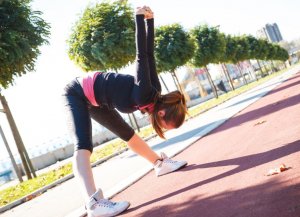Static Stretching vs. Ballistic Stretching

Stretching is an essential part of your training. After a long session of aerobic exercise, the muscles need to release the stresses of the effort made. But there are two different ways of stretching: static stretching or ballistic stretching.
If you don’t stretch properly after working out, your body won’t be able to take the strain. Not stretching can lead to severe pain and even injuries. This is why either static or ballistic, an athlete must stretch properly after every workout.
Certain sports tend to prefer one of these two types over the other. Soccer players, for example, take advantage of the rebound movement used in ballistic stretching. Other disciplines, such as yoga, treat the muscles to a gentle, static stretch.
Static stretching; what does it entail?
Static stretching is one of the most frequently used stretching techniques. As a general rule, the stretches are executed in order to improve the flexibility of the muscles and joints that were activated during the training. This way, static stretching is a great way to prevent contractures and cramps.
These kinds of stretches don’t follow a single routine: movements can be combined in an infinite number of ways. The sequence changes according to the goals of the routine. Sometimes, the goal of stretching is to rehabilitate an injured muscle; others times, it’s just to elongate and improve flexibility.
Discover more: Three Exercises for Improving Flexibility
During the static stretch, the athlete stretches the muscle while resting, accompanying the movement by adequate breathing. The muscle remains elongated for three or four deep breaths, during which you try to stretch it a little more in each exhalation. Be careful not to bounce your body, just hold the stretch.
These are called static stretches because, during the routines, your body hardly spends energy. In this sense, muscle relaxation occurs at a deep level, which promotes cardiovascular health. The main goal of static stretching is to bring the muscle to a comfortable limit.

Proprioceptive neuromuscular facilitation method (PNF) stretches
Isometric stretches are usually combined with static stretches to improve flexibility. Isometric stretching consists of stretching the muscle in the opposite direction to the elongation.
Proprioceptive neuromuscular facilitation method, also known as PNF, has four phases. PNF is one of the methods that combine isometric and static stretches. Basically, you start by stretching a muscle in the traditional way and right after you stretch in the opposite way, in an isometric fashion.
You might also like: Isometric Exercises: A Routine To Tone Your Body
You should maintain the position through five deep breaths. From the isometric stretch, you should return back to the static stretch position, before releasing the tension. You’ll notice how you have greater mobility the second time you hold the static stretching position.
Ballistic stretch: benefits and contraindications
Ballistic stretching consists mainly in bouncing instead of holding a static position. Therefore, you should always warm up thoroughly before stretching this way.
Ballistic stretching is often used in disciplines such as dance, martial arts or rhythmic gymnastics. This kind of stretching is considered dynamic because you are supposed to be moving while stretching.
While the static stretch keeps the muscle fixed to its maximum extent, the ballistic makes the muscle bounce stretching and relaxing in quick succession.
Yet, whether ballistic stretching is beneficial or not is controversial. Many coaches consider that the effect of suddenly stretching a tensioned muscle and bouncing it is counterproductive and even dangerous.

Let’s exemplify the stretching methods. If you want to stretch your hamstrings, you should bend your body forward and aim to touch the tips of your toes. This is true both for a static stretch and ballistic stretch.
Yet, if you want to stretch your hamstrings using this movement through a static stretch, you should hold the position between 10 and 15 seconds before releasing. On the other hand, if you want to stretch your hamstrings using this movement through a ballistic stretch, you should bounce your upper body in quick movements, trying to touch the tips of your toes every time you reach down.
As you can see, the former makes your body relaxed. The latter forces your body to engage the muscles. If you want to know which one is best for you, you should ask your coach. They’ll know what the best approach is to stretching in your chosen discipline.
Stretching is an essential part of your training. After a long session of aerobic exercise, the muscles need to release the stresses of the effort made. But there are two different ways of stretching: static stretching or ballistic stretching.
If you don’t stretch properly after working out, your body won’t be able to take the strain. Not stretching can lead to severe pain and even injuries. This is why either static or ballistic, an athlete must stretch properly after every workout.
Certain sports tend to prefer one of these two types over the other. Soccer players, for example, take advantage of the rebound movement used in ballistic stretching. Other disciplines, such as yoga, treat the muscles to a gentle, static stretch.
Static stretching; what does it entail?
Static stretching is one of the most frequently used stretching techniques. As a general rule, the stretches are executed in order to improve the flexibility of the muscles and joints that were activated during the training. This way, static stretching is a great way to prevent contractures and cramps.
These kinds of stretches don’t follow a single routine: movements can be combined in an infinite number of ways. The sequence changes according to the goals of the routine. Sometimes, the goal of stretching is to rehabilitate an injured muscle; others times, it’s just to elongate and improve flexibility.
Discover more: Three Exercises for Improving Flexibility
During the static stretch, the athlete stretches the muscle while resting, accompanying the movement by adequate breathing. The muscle remains elongated for three or four deep breaths, during which you try to stretch it a little more in each exhalation. Be careful not to bounce your body, just hold the stretch.
These are called static stretches because, during the routines, your body hardly spends energy. In this sense, muscle relaxation occurs at a deep level, which promotes cardiovascular health. The main goal of static stretching is to bring the muscle to a comfortable limit.

Proprioceptive neuromuscular facilitation method (PNF) stretches
Isometric stretches are usually combined with static stretches to improve flexibility. Isometric stretching consists of stretching the muscle in the opposite direction to the elongation.
Proprioceptive neuromuscular facilitation method, also known as PNF, has four phases. PNF is one of the methods that combine isometric and static stretches. Basically, you start by stretching a muscle in the traditional way and right after you stretch in the opposite way, in an isometric fashion.
You might also like: Isometric Exercises: A Routine To Tone Your Body
You should maintain the position through five deep breaths. From the isometric stretch, you should return back to the static stretch position, before releasing the tension. You’ll notice how you have greater mobility the second time you hold the static stretching position.
Ballistic stretch: benefits and contraindications
Ballistic stretching consists mainly in bouncing instead of holding a static position. Therefore, you should always warm up thoroughly before stretching this way.
Ballistic stretching is often used in disciplines such as dance, martial arts or rhythmic gymnastics. This kind of stretching is considered dynamic because you are supposed to be moving while stretching.
While the static stretch keeps the muscle fixed to its maximum extent, the ballistic makes the muscle bounce stretching and relaxing in quick succession.
Yet, whether ballistic stretching is beneficial or not is controversial. Many coaches consider that the effect of suddenly stretching a tensioned muscle and bouncing it is counterproductive and even dangerous.

Let’s exemplify the stretching methods. If you want to stretch your hamstrings, you should bend your body forward and aim to touch the tips of your toes. This is true both for a static stretch and ballistic stretch.
Yet, if you want to stretch your hamstrings using this movement through a static stretch, you should hold the position between 10 and 15 seconds before releasing. On the other hand, if you want to stretch your hamstrings using this movement through a ballistic stretch, you should bounce your upper body in quick movements, trying to touch the tips of your toes every time you reach down.
As you can see, the former makes your body relaxed. The latter forces your body to engage the muscles. If you want to know which one is best for you, you should ask your coach. They’ll know what the best approach is to stretching in your chosen discipline.
All cited sources were thoroughly reviewed by our team to ensure their quality, reliability, currency, and validity. The bibliography of this article was considered reliable and of academic or scientific accuracy.
- Julio Gutiérrez Muñoz. Estiramientos. Extraído de: http://www.sld.cu/galerias/pdf/sitios/rehabilitacion-ejer/estiramientos_1.pdf
- Mònica Solana Tramunt. 2007. Los estiramientos. Extraído de: https://www.raco.cat/index.php/Aloma/article/viewFile/92265/117461
This text is provided for informational purposes only and does not replace consultation with a professional. If in doubt, consult your specialist.








